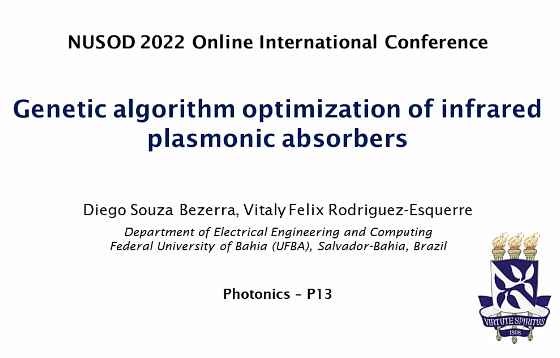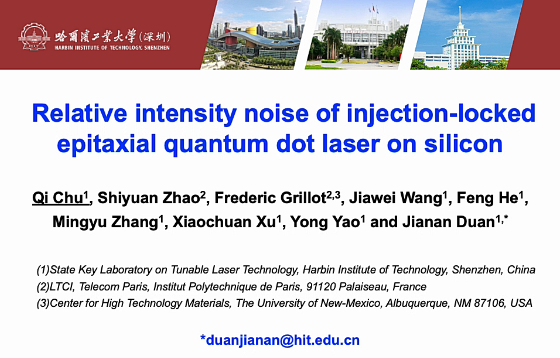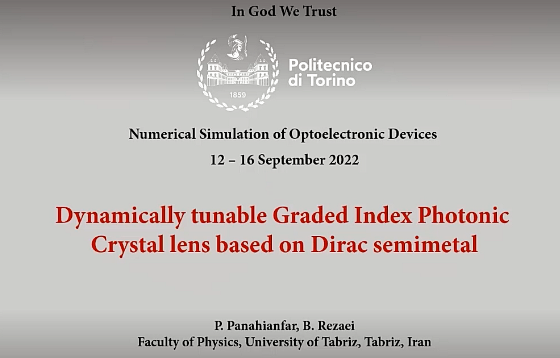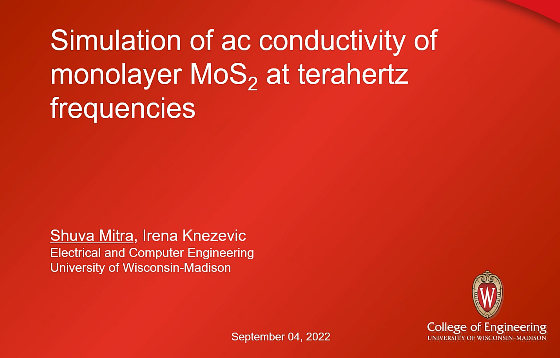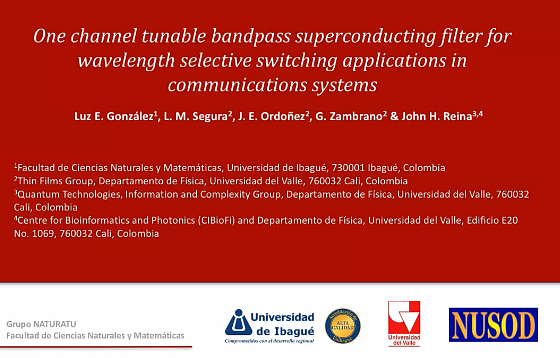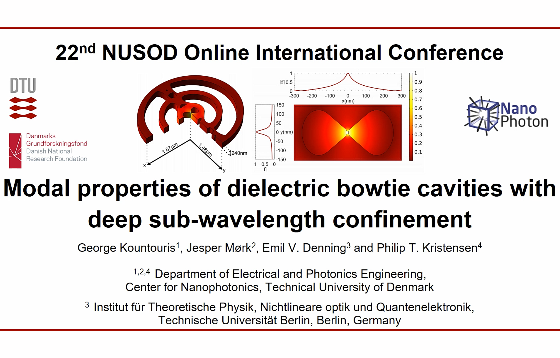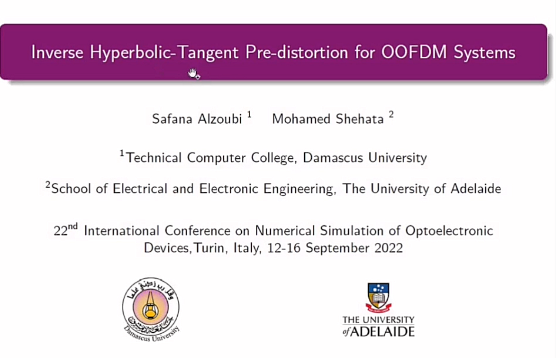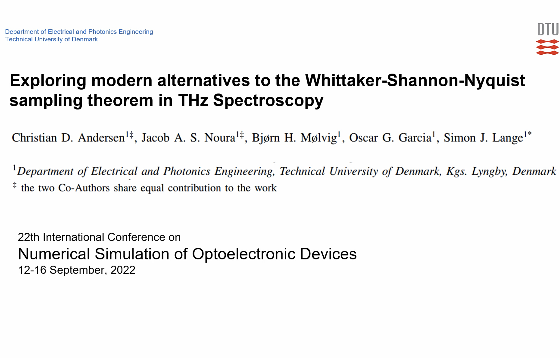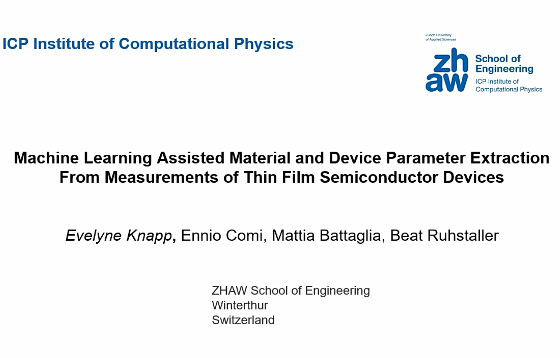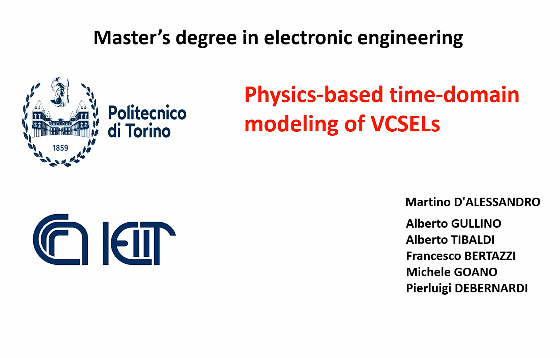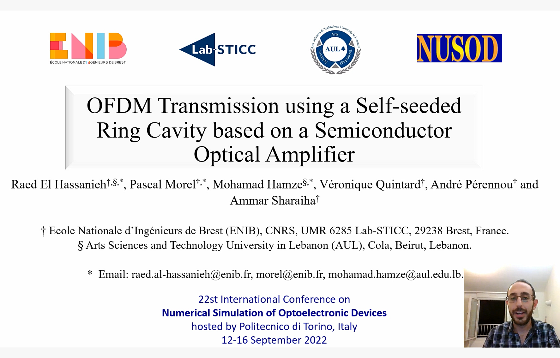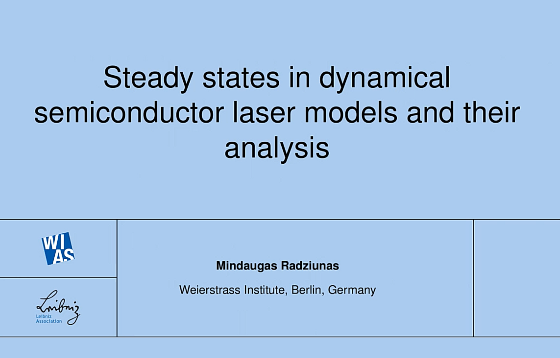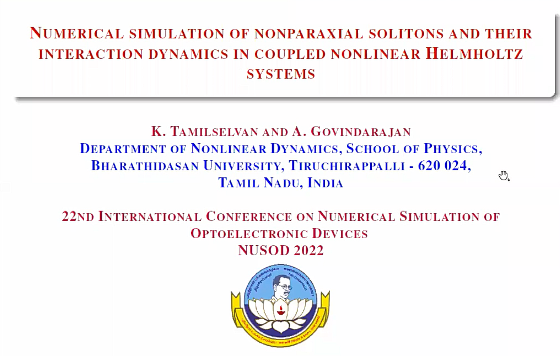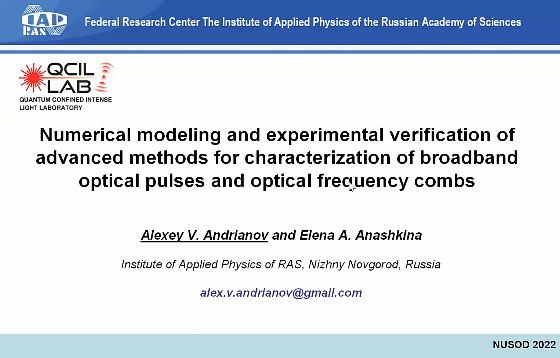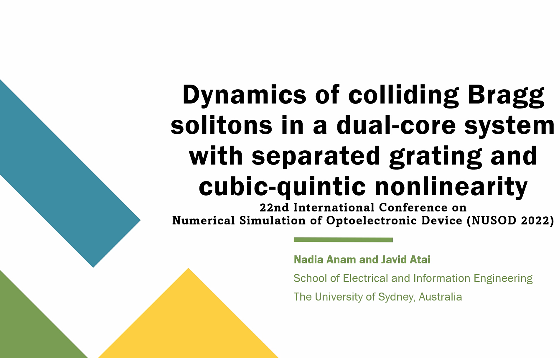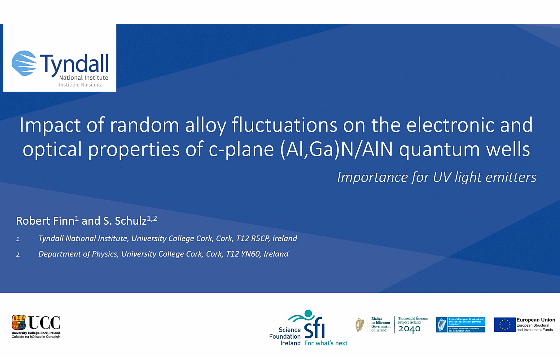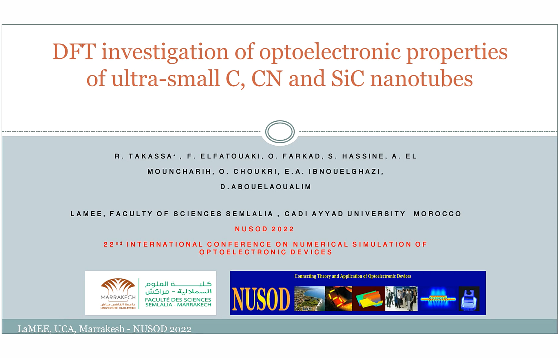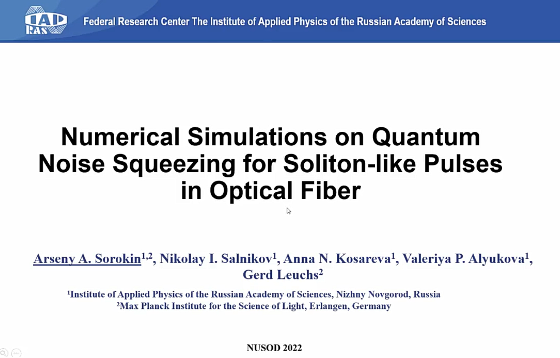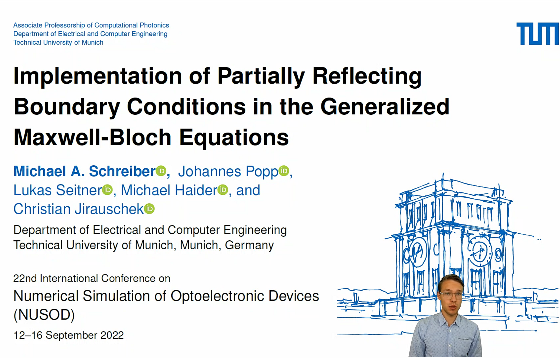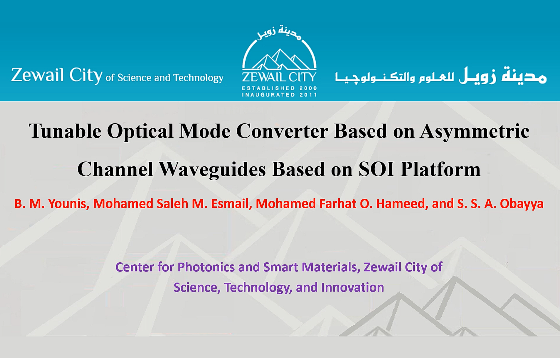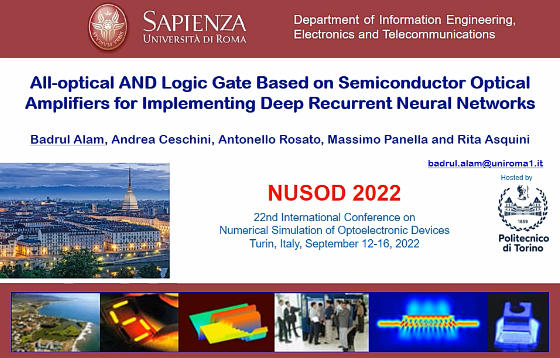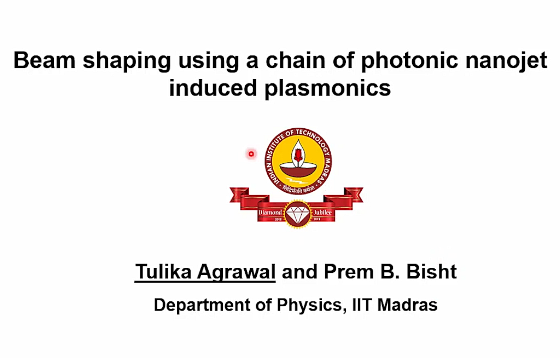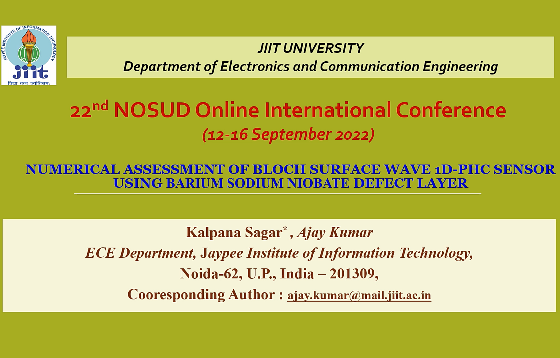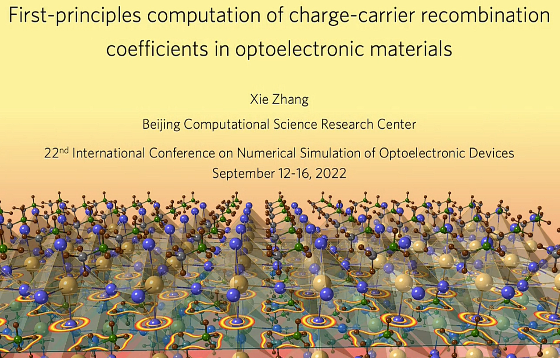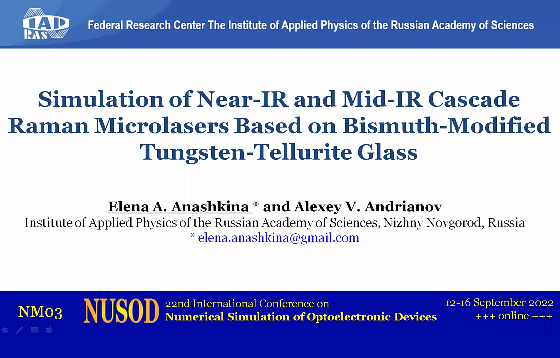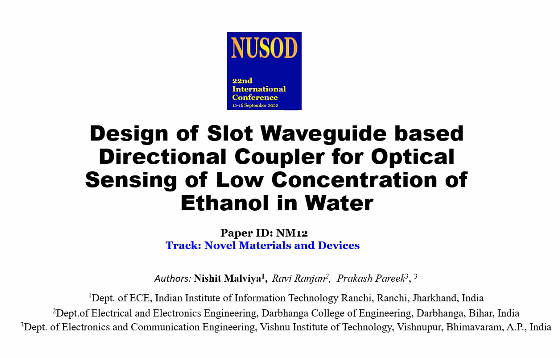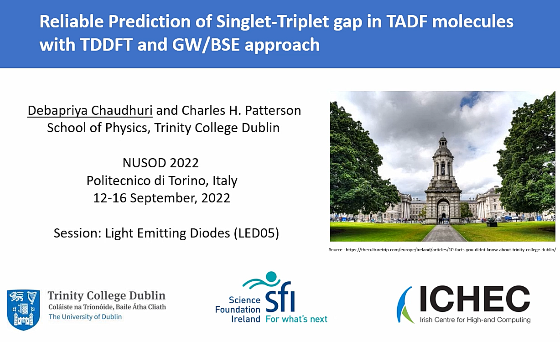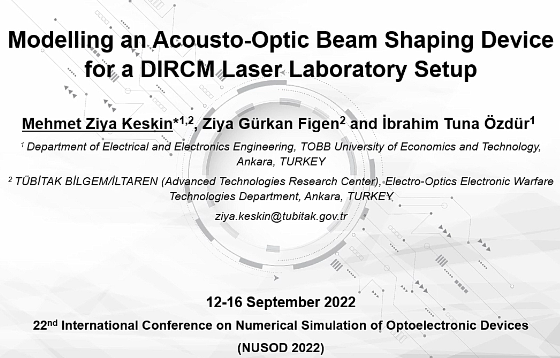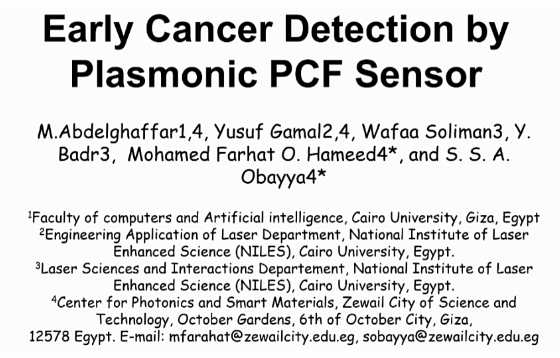


The absorption of a multiband absorber based on a periodical plasmonic grating has been optimized. The optical and geometrical parameters of the plasmonic structure which is composed of germanium and gold are determined by an efficient genetic algorithm. The electromagnetic response of the absorber is numerically obtained by using the frequency domain finite element method. […]
LD06 – Relative intensity noise of injection-locked epitaxial quantum dot laser on silicon
This work investigates the relative intensity noise (RIN) characteristics of quantum dot (QD) lasers epitaxially grown on silicon subject to the optical injection. The effect of threading dislocation (TD), which acts as nonradiative recombination centers in the Shockley-Read-Hall (SRH) process, is considered in the rate equation model. The results reveal that the RIN is enhanced […]
P14 – Dynamically tunable Graded Index Photonic Crystal lens based on Dirac semimetal
In this paper, we design a graded-index photonic crystal based on Dirac semimetals and simulate the light propagation in the proposed structure using two-dimensional finite-difference time-domain method. The numerical results indicate that the designed GRIN PC has focusing capability for incident light at terahertz frequency range, and its focal distance can be tuned through changing […]
MM04 – Simulation of ac conductivity of monolayer MoS2 at terahertz frequencies
We present a multiphysics numerical tool for calculating the terahertz (THz) conductivity of transition-metal dichalcogenides (TMDs). The tool combines the ensemble Monte Carlo (EMC) technique for carrier transport with a three-dimensional finite-difference-time-domain (FDTD) solver for electromagnetic fields. We use the coupled EMC–FDTD technique to calculate the frequency-dependent conductivity in the terahertz range for monolayer MoS2, […]
NM10 – One channel tunable bandpass superconducting filter for wavelength selective switching applications in communications systems
We design and evaluate the performance of optical filters that are built from one-dimensional photonic crystals (PhCs) amenable for integration into optical networks based on wavelength division multiplexing (WDM). The photonic heterostructures comprise the integration of a ferroelectric (BaTiO3), a dielectric (Y2O3), and a critical high-temperature superconductor material (YBa2Cu3O7−X) in between. Such nanosystems can allow […]
MM06 – Dual-Potential Finite-Difference Technique for Computational Electrodynamics
We present a finite-difference time-domain (FDTD) technique suitable for coupling with quantum-transport solvers. We derive first-order equations for the electric and magnetic vector potentials and the electric scalar potential which, upon the adoption of the Coulomb gauge, decouple into solenoidal and irrotational equation sets and are sourced by the solenoidal and irrotational parts of the […]
P02 – Modal properties of dielectric bowtie cavities with deep sub-wavelength confinement
We present a quasinormal mode analysis of a dielectric bowtie cavity with deep sub-wavelength confinement. The cavity – which is based on an inverse design by topology optimization – exhibits a remarkable sensitivity to local shape deformations, which we show to be well described by perturbation theory.
IS15 – Inverse Hyperbolic-Tangent Pre-distortion for OOFDM Systems
We propose an inverse hyperbolic-tangent-based digital pre-distorter that can suppress the Mach-Zehnder modulator-induced harmonic distortions by about 13 dB for single-tone signals, while maintaining the peak-to-average power ratio in optical orthogonal frequency division multiplexed signals.
IS02 – Exploring modern alternatives to the Whittaker-Shannon-Nyquist sampling theorem in THz Spectroscopy
We present simulations for a THz cross-correlation spectroscopy (THz-CCS) optical system. The aim is using compressed sensing (CS) to reconstruct the THz signal from a random under sampling of the signal and potentially replacing a delay stage unit of the THz-CCS system to increase robustness and cost-effectiveness of the optical system. We present results from […]
NM01 – Machine Learning Assisted Material and Device Parameter Extraction From Measurements Of Thin Film Semiconductor Devices
The simulation of thin film semiconductor devices is challenging, partly due to the unknown material and device parameters. In this contribution, we present two different approaches to determine the missing material and device parameters from measurements. They both have in common that they are based on machine learning (ML) and numerical models. First, a numerical […]
LD07 – Physics-based time-domain modeling of VCSELs
This paper presents the results of a physics-based time-domain simulator for a vertical-cavity surface-emitting laser (VCSEL). We implemented a trapezoidal rule second order backward differentiation formula (TR-BDF2) to simulate the large signal response of the device under investigation, including the parasitic effects of the pin junction arising from an interplay of optical and carrier transport […]
IS07 – OFDM Transmission using a Self-seeded ring Cavity based on a Semiconductor Optical Amplifier
This paper discusses the transmission of optical Orthogonal Frequency-Division Multiplexing (OFDM) format modulation in a resonant cavity based on a Semiconductor Optical Amplifiers Fiber Cavity Laser (SOA-FCL). The OFDM Subcarriers are configured and transmitted to fit the Cavity Resonance Modes (CRM). As a result, the authors show a novel principle of OFDM transmission in a […]
LD01 – Steady states in dynamical semiconductor laser models and their analysis
We present an algorithm for calculating steady states in the dynamic PDE model for SLs admitting gain compression, spatial hole burning, and multilevel carrier rate equations. Presented example simulations rely on 1(time)+1(space)-dimensional traveling-wave- and Lang-Kobayashi-type models.
N06 – Numerical simulations of nonparaxial solitons and their interaction dynamics in coupled Helmholtz systems
The role of nonparaxiality provides a fertile ground for fabricating miniaturized nanoscale devices. In this work, we examine the existence of nonparaxial solitons in a dimensionless coupled nonlinear Helmholtz system, allowing the propagation of ultra-broad nonparaxial pulses in a birefringent optical waveguide. We analytically obtain a bright soltion solution by using standard Hirota’s bilinearization method. […]
P04 – Numerical modeling and experimental verification of advanced methods for characterization of broadband optical pulses and optical frequency combs
We propose novel linear method for measuring ultrafast pulse trains with extremely high pulse repetition rates that are commonly generated in nonlinear microresonators. The method combines single-shot spectral interferometry with the reference pulses and an advanced version of the frequency resolved optical gating algorithm to reconstruct the initially unknown reference pulses.
P22 – Dynamics of colliding Bragg solitons in a dual-core system with separated grating and cubic-quintic nonlinearity
We investigate the collisions of counterpropagating Bragg solitons in a dual-core optical coupler where one core has cubic-quintic nonlinearity and is coupled to another linear core equipped with a uniform Bragg grating. The outcomes of the collisions are diverse and exhibit rich dynamics.
NM02 – Impact of random alloy fluctuations on the electronic and optical properties of c-plane AlxGa1−xN/AlN quantum wells
We present a theoretical study of the electronic and optical properties of c-plane AlxGa1−xN/AlN quantum wells emitting in the ultraviolet-A (UV-A) to UV-C spectral range. Special attention is paid to the impact of alloy fluctuations on the results. We find that random alloy fluctuations in (Al,Ga)N are already sufficient to cause strong carrier localization effects. […]
N07 – DFT investigation of optoelectronic properties of ultra-small C, CN and SiC nanotubes
We investigated the optoelectronic properties of ultra-small armchair (3,3) carbon (C), carbon nitride (CN) and silicon cabride (SiC) nanotubes using the density functional theory (DFT). We performed the calculations for two potentials Perdew-Burke-Ernzerhof Generalized Gradient Approximation (PBEGGA) and Tran-Blaha modified Becke-Johnson (TB-mBJ) potential. The results show a semiconducting nature with direct and indirect gap for […]
P03 – Numerical Simulations on Quantum Noise Squeezing for Soliton-like Pulses in Optical Fiber
Generation of light with nonclassical properties, such as squeezed light, has gathered a lot of attention because of possible uses in such areas as quantum state engineering, quantum imaging, continuous variable quantum computing, and detection of gravitational waves. Squeezed light is generally produced by transporting light through a nonlinear medium. One such media is Kerr-nonlinear […]
MM03 – Implementation of Partially Reflecting Boundary Conditions in the Generalized Maxwell-Bloch Equations
Perfectly matched layer (PML) boundary conditions have been used for several decades for the simulation of open domains within the finite difference time domain (FDTD) method. In this paper, we report on a new PML-based partially reflecting boundary condition for the generalized Maxwell-Bloch equations that enables setting a certain value of reflectance R at the […]
IS14 – Tunable optical mode converter based on SOI asymmetric channel waveguides
An optical mode converter based on asymmetric dual channel waveguides is reported and analyzed. The first channel is infiltrated with nematic liquid crystal (NLC) material while the second one has BK7 glass core. The first higher order mode of the NLC core is coupled to the fundamental mode of the neighboring core with high coupling […]
IS04 – All-optical AND Logic Gate Based on Semiconductor Optical Amplifiers for Implementing Deep Recurrent Neural Networks
The development of optical logic gates is a key factor for enabling next generation of computations in the context of Deep Learning and Quantum Computing. In this work, we introduce a scheme for the implementation of an all-optical AND logic gate, which makes use of semiconductor optical amplifiers (SOA) in cross-phase modulation configuration combined with […]
N09 – Beam shaping using a chain of photonic nanojet induced plasmonics
Photonic nanojet arises from a microcavity leading to high electric field. On the other hand, metal nanoparticles (NPs) lead to high field due to localization in small volumes. In this work, PNJ from an array of cavity induced plasmon resonances has been studied. The sharp profile of the PNJ has been observed by the inclusion […]
P19 – Numerical Assessment of Bloch Surface Wave 1D-PhC Sensor using Ba2NaNb5O15 Defect Layer
In this paper, a top defective layer of Barium sodium niobate (Ba2NaNb5O15) material of nanometer range thickness is used to confine Bloch surface mode at the upper interface of the proposed structure. For a 1275 nm operating wavelength, the structural characteristics are intended to stimulate a BSW at the top interface. Wavelength interrogation, angle interrogation, […]
LED01 – First-principles computation of charge-carrier recombination coefficients in optoelectronic materials
Charge-carrier recombination plays a decisive role in determining the efficiency of optoelectronic materials and devices, but their accurate experimental measurements and interpretation are challenging. In this context, first-principles computation of charge-carrier recombination coefficients is particularly useful. It allows not only rigorous computation of the recombination rates, but also intuitive interpretation of the microscopic recombination mechanisms […]
NM03 – Simulation of Near-IR and Mid-IR Cascade Raman Microlasers Based on Bismuth-Modified Tungsten-Tellurite Glass
We theoretically investigate cascade Raman generation in bismuth-modified tungsten-tellurite glass microlasers, for the first time for microcavities based on TeO2 glasses. The calculated results demonstrate the opportunities of CW Raman generation in the near-IR and mid-IR ranges with CW pump at the wavelength of 1.55 μm. The predicted wavelengths are 1.81 µm, 2.17 µm, 2.70 […]
NM12 – Design of Slot Waveguide based Directional Coupler for Optical Sensing of low concentration of Ethanol in Water
In this study, sensing of low concentration (0-10%) of ethanol in water is presented by refractive index sensing by silicon slot waveguide-based direction coupler. The significance spectral variation and sensitivity is observed to detect low concentration of ethanol in water.
LED05 – Reliable prediction of the singlet-triplet gap in TADF molecules with GW/BSE approach
Organic light emitting diode (OLED) molecules that exhibit thermally activated delayed fluorescence (TADF) have emerged as a promising technology for various lighting and display applications. Such systems depend on low singlet-triplet gaps of the order of kT to allow reverse inter-system crossing. Here, we demonstrate the capability of a GW/BSE method to predict excitation energies […]
NM06 – Modelling an Acousto-Optic Beam Shaping Device for a DIRCM Laser Laboratory Setup
Directed Infrared Counter Measure (DIRCM) laser laboratory setups are used to mimic the real life DIRCM system and IR heat-seeking missile engagement scenarios in isolated laboratory environments. Typically, the output beam of a mid-infrared (Mid-IR) laser source is modulated in time using an acousto-optic (AO) modulator (AOM). Following the AOM in the optical path, within […]
NM07 – Early Cancer Detection by Plasmonic PCF Sensor
Great research work has been studied for cancer detection due to its high death rate. In this paper, a novel design of photonic crystal fiber (PCF) biosensor based on surface plasmon resonance (SPR) is introduced and numerically analyzed for cancer cell detection. Full vectorial finite element method (FVFEM) is used throughout the numerical analysis of […]

